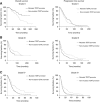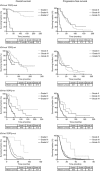TERT promoter mutations in gliomas, genetic associations and clinico-pathological correlations
- PMID: 25314060
- PMCID: PMC4229642
- DOI: 10.1038/bjc.2014.538
TERT promoter mutations in gliomas, genetic associations and clinico-pathological correlations
Abstract
Background: The role of telomerase reverse transcriptase (TERT) in gliomagenesis has been recently further strengthened by the frequent occurrence of TERT promoter mutations (TERTp-mut) in gliomas and evidence that the TERT SNP genetic rs2736100 influences glioma risk. TERTp-mut creates a binding site for Ets/TCF transcription factors, whereas the common rs2853669 polymorphism disrupts another Ets/TCF site on TERT promoter.
Methods: We sequenced for TERTp-mut in 807 glioma DNAs and in 235 blood DNAs and analysed TERT expression by RT-PCR in 151 samples. TERTp-mut status and TERTp polymorphism rs2853669 were correlated with histology, genomic profile, TERT mRNA expression, clinical outcome and rs2736100 genotype.
Results: TERTp-mut identified in 60.8% of gliomas (491 out of 807) was globally associated with poorer outcome (Hazard ratio (HR)=1.50). We defined, based on TERTp-mut and IDH mutation status, four prognostic groups: (1) TERTp-mut and IDH-mut associated with 1p19q codeletion, overall survival (OS)>17 years; (2) TERTp-wt and IDH-mut, associated with TP53 mutation, OS=97.5 months; (3) TERTp-wt and IDH-wt, with no specific association, OS=31.6 months; (4) TERTp-mut and IDH-wt, associated with EGFR amplification, OS=15.4 months. TERTp-mut was associated with higher TERT mRNA expression, whereas the rs2853669 variant was associated with lower TERT mRNA expression. The mutation of CIC (a repressor of ETV1-5 belonging to the Ets/TCF family) was also associated with TERT mRNA upregulation.
Conclusions: In addition to IDH mutation status, defining the TERTp-mut status of glial tumours should afford enhanced prognostic stratification of patients with glioma. We also show that TERTp-mut, rs2853669 variant and CIC mutation influence Tert expression. This effect could be mediated by Ets/TCF transcription factors.
Figures






References
-
- Aapola U, Kawasaki K, Scott HS, Ollila J, Vihinen M, Heino M, Shintani A, Minoshima S, Krohn K, Antonarakis SE, Shimizu N, Kudoh J, Peterson P. Isolation and initial characterization of a novel zinc finger gene, DNMT3L, on 21q22.3, related to the cytosine-5-methyltransferase 3 gene family. Genomics. 2000;65 (3:293–298. - PubMed
-
- Arita H, Narita Y, Fukushima S, Tateishi K, Matsushita Y, Yoshida A, Miyakita Y, Ohno M, Collins VP, Kawahara N, Shibui S, Ichimura K. Upregulating mutations in the TERT promoter commonly occur in adult malignant gliomas and are strongly associated with total 1p19q loss. Acta Neuropathol. 2013;126 (2:267–276. - PubMed
-
- Aubert G, Lansdorp PM. Telomeres and aging. Physiol Rev. 2008;88 (2:557–579. - PubMed
-
- Bettegowda C, Agrawal N, Jiao Y, Sausen M, Wood LD, Hruban RH, Rodriguez FJ, Cahill DP, McLendon R, Riggins G, Velculescu VE, Oba-Shinjo SM, Marie SK, Vogelstein B, Bigner D, Yan H, Papadopoulos N, Kinzler KW. Mutations in CIC and FUBP1 contribute to human oligodendroglioma. Science. 2011;333 (6048:1453–1455. - PMC - PubMed
-
- Brennan CW, Verhaak RG, McKenna A, Campos B, Noushmehr H, Salama SR, Zheng S, Chakravarty D, Sanborn JZ, Berman SH, Beroukhim R, Bernard B, Wu CJ, Genovese G, Shmulevich I, Barnholtz-Sloan J, Zou L, Vegesna R, Shukla SA, Ciriello G, Yung WK, Zhang W, Sougnez C, Mikkelsen T, Aldape K, Bigner DD, Van Meir EG, Prados M, Sloan A, Black KL, Eschbacher J, Finocchiaro G, Friedman W, Andrews DW, Guha A, Iacocca M, O'Neill BP, Foltz G, Myers J, Weisenberger DJ, Penny R, Kucherlapati R, Perou CM, Hayes DN, Gibbs R, Marra M, Mills GB, Lander E, Spellman P, Wilson R, Sander C, Weinstein J, Meyerson M, Gabriel S, Laird PW, Haussler D, Getz G, Chin L. The somatic genomic landscape of glioblastoma. Cell. 2013;155 (2:462–477. - PMC - PubMed
Publication types
MeSH terms
Substances
Grants and funding
LinkOut - more resources
Full Text Sources
Other Literature Sources
Medical
Research Materials
Miscellaneous

